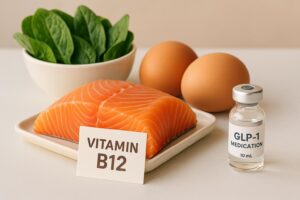How to Increase GLP-1 Naturally for Better Health

Introduction
In the world of nutrition and weight management, one hormone has recently taken center stage: glucagon-like peptide-1 (GLP-1). This hormone, produced in the gut, plays a pivotal role in regulating appetite and blood sugar levels. Interestingly, many of us may not have been aware of GLP-1 just a few years ago, but its importance has become increasingly clear as we delve deeper into the connection between our diets and overall health.
With the rise of weight loss medications such as semaglutide (Ozempic, Wegovy) and tirzepatide (Mounjaro, Zepbound), there’s been significant interest in understanding how we can naturally boost GLP-1 levels through lifestyle changes and dietary choices. In this blog post, we will explore how to increase GLP-1 naturally, discussing the mechanisms behind its function, the impact of our diet, and lifestyle adjustments that can enhance its production.
By the end of this guide, you will have a comprehensive understanding of GLP-1 and the actionable steps you can take to naturally elevate its levels in your body, promoting better metabolic health and aiding in weight management. We will cover the types of foods that stimulate GLP-1 production, the importance of gut health, the role of physical activity, and the overall significance of a balanced lifestyle.
So, if you’ve ever wondered how to harness the power of GLP-1 for your health, you’re in the right place. Let’s embark on this journey together to unlock the potential of this remarkable hormone!
Understanding GLP-1: The Hormone That Matters
What is GLP-1?
GLP-1 is a hormone that belongs to the incretin family, which is secreted by the intestinal cells in response to food intake. It plays several crucial roles in our body, including:
-
Stimulating Insulin Secretion: After a meal, GLP-1 signals the pancreas to release insulin, which helps lower blood sugar levels by facilitating the uptake of glucose into cells.
-
Slowing Gastric Emptying: GLP-1 slows down the rate at which food leaves the stomach, leading to a gradual release of glucose into the bloodstream and preventing spikes in blood sugar levels.
-
Reducing Appetite: By acting on the brain, GLP-1 signals feelings of satiety, helping to curb hunger and reduce overall food intake.
-
Inhibiting Glucagon Secretion: GLP-1 decreases the release of glucagon, a hormone that raises blood sugar levels, thereby supporting more stable blood sugar management.
These actions make GLP-1 a vital player in metabolic health, particularly for individuals managing weight or blood sugar levels.
Why is GLP-1 Gaining Attention?
The recent popularity of GLP-1 has been fueled by the success of medications that mimic its effects. Clinical trials have shown that these medications can lead to significant weight loss and improved metabolic outcomes for individuals with obesity or type 2 diabetes. For example, studies indicate that participants using GLP-1 receptor agonists can experience an average weight loss of 15% over a period of 68 weeks.
However, while these medications provide a powerful tool, they are not the only solution. Understanding how to naturally enhance GLP-1 levels through diet and lifestyle can empower individuals to take control of their health in a sustainable way.
The Role of the Gut Microbiome
At the heart of GLP-1 production is the gut microbiome. Our intestines are home to trillions of microorganisms that play a crucial role in digestion and overall health. Certain gut bacteria produce metabolites, such as short-chain fatty acids (SCFAs), that stimulate the release of GLP-1. This connection emphasizes the importance of maintaining a healthy gut environment for optimal GLP-1 production.
Foods That Naturally Increase GLP-1
To effectively boost GLP-1 levels, we can turn to specific foods that are known to trigger its release. Here are some key categories of foods to incorporate into your diet:
1. High-Fiber Foods
Fiber is one of the most effective nutrients for stimulating GLP-1 production. Here are some fiber-rich foods to include:
- Whole Grains: Foods like oats, barley, and quinoa are packed with soluble fiber that can ferment in the gut, producing SCFAs that promote GLP-1 secretion.
- Fruits and Vegetables: Apples, pears, Brussels sprouts, carrots, and citrus fruits are excellent sources of fiber and can help increase GLP-1 levels.
- Legumes: Beans, lentils, and peas are not only high in fiber but also provide valuable protein, further supporting GLP-1 release.
2. Healthy Fats
Incorporating healthy fats into your meals can also stimulate GLP-1 production. Foods to consider include:
- Avocados: Rich in monounsaturated fats and fiber, avocados can enhance satiety and promote GLP-1 secretion.
- Olive Oil: This heart-healthy fat has been shown to increase GLP-1 levels compared to saturated fats.
- Fatty Fish: Salmon and other fatty fish are great sources of omega-3 fatty acids, which have been linked to improved insulin sensitivity and GLP-1 secretion.
3. Lean Proteins
Protein intake is essential for GLP-1 release, as certain amino acids can stimulate its production. Include sources of lean protein in your meals, such as:
- Eggs: A versatile protein source, eggs can support satiety and GLP-1 levels.
- Poultry and Fish: Chicken, turkey, and fish are excellent lean protein options that can help regulate appetite and promote GLP-1 release.
- Nuts and Seeds: Almonds, walnuts, and chia seeds not only provide protein but also healthy fats and fiber.
4. Fermentable Fibers
Fermentable fibers are particularly effective at enhancing GLP-1 levels. These include:
- Beta-Glucans: Found in oats and barley, beta-glucans can effectively stimulate GLP-1 production.
- Inulin: Present in foods like chicory root, garlic, and onions, inulin is a prebiotic fiber that can enhance gut health and GLP-1 secretion.
5. Prebiotics and Probiotics
Supporting gut health is crucial for optimal GLP-1 production. Incorporating prebiotic and probiotic-rich foods can be beneficial:
- Prebiotics: Foods like garlic, onions, and asparagus feed beneficial gut bacteria, promoting the production of SCFAs that stimulate GLP-1.
- Probiotics: Fermented foods such as yogurt, kefir, and sauerkraut can enhance gut health and may influence GLP-1 levels positively.
The Importance of Physical Activity
In addition to dietary changes, regular physical activity has been shown to enhance GLP-1 levels. Engaging in both aerobic and resistance training can promote better insulin sensitivity and metabolic health. Studies suggest that even a single session of moderate to high-intensity exercise can boost GLP-1 levels, with benefits lasting for hours after the activity.
Aim for at least 150 minutes of moderate-intensity exercise per week, combined with two days of strength training. This not only helps in increasing GLP-1 but also supports overall cardiovascular health, weight management, and improved mood.
Practicing Mindful Eating
The way we eat can also influence GLP-1 secretion. Mindful eating practices, such as slowing down during meals and savoring each bite, can enhance the body’s hormonal response. When we eat more slowly, our bodies have time to respond to the nutrients consumed, allowing hormones like GLP-1 to be released effectively.
Consider the following tips for mindful eating:
- Eat Without Distractions: Turn off screens and focus on your meal to enhance awareness and satisfaction.
- Chew Thoroughly: Chewing food well can aid digestion and promote the release of hormones that support satiety.
- Listen to Your Body: Pay attention to hunger and fullness cues, allowing your body to guide your eating habits.
Conclusion
Increasing GLP-1 naturally through dietary adjustments, physical activity, and mindful eating can significantly enhance your metabolic health and support your weight management goals. By focusing on fiber-rich foods, healthy fats, lean proteins, and maintaining a balanced gut microbiome, we can empower ourselves to take control of our health in a sustainable manner.
At TrimRx, we understand that weight management is a personal journey, and we are dedicated to providing personalized, medically supervised weight loss solutions. If you’re interested in exploring how our programs can support your weight management goals, we encourage you to take our free assessment quiz here.
Additionally, consider supporting your weight loss journey with our quick-access supplements, including our GLP-1 Daily Support and Weight Loss Boost.
Together, let’s take proactive steps towards better health and wellness by harnessing the power of GLP-1!
FAQ
What is GLP-1?
GLP-1 is a hormone produced in the gut that plays a crucial role in regulating blood sugar levels and appetite. It stimulates insulin secretion, slows gastric emptying, and promotes feelings of fullness.
How can I naturally increase GLP-1 levels?
You can increase GLP-1 levels by consuming high-fiber foods, healthy fats, lean proteins, and prebiotics and probiotics. Regular exercise and mindful eating practices also contribute to enhancing GLP-1 production.
Are there any foods specifically known to boost GLP-1?
Yes, foods like oats, barley, avocados, beans, and leafy greens are known to stimulate GLP-1 production. Incorporating these into your meals can help support your body’s natural GLP-1 levels.
Can exercise help increase GLP-1?
Yes, regular physical activity, especially moderate to high-intensity exercise, can boost GLP-1 levels. Aim for at least 150 minutes of exercise each week for optimal benefits.
Is it better to rely on medications for GLP-1 or to make dietary changes?
While GLP-1 medications can be effective, making dietary changes and lifestyle adjustments can also significantly support GLP-1 production and overall health. A combination of both approaches may be beneficial for long-term success.

Transforming Lives, One Step at a Time
Keep reading
Vitamin B12 and GLP-1 Medications: What to Know
GLP-1 medications can lower B12 absorption and intake; learn symptoms, food sources, supplement options, and how to monitor levels.
Semaglutide Injection Site Reactions: What To Know
Learn why semaglutide injections can cause redness, swelling or nodules, how to prevent and treat them, and when to seek medical care.
TrimRx vs Friday’s
Compare TrimRx and Friday’s telehealth GLP-1 weight-loss programs: pricing, medical support, coaching, delivery, and which fits your needs.



